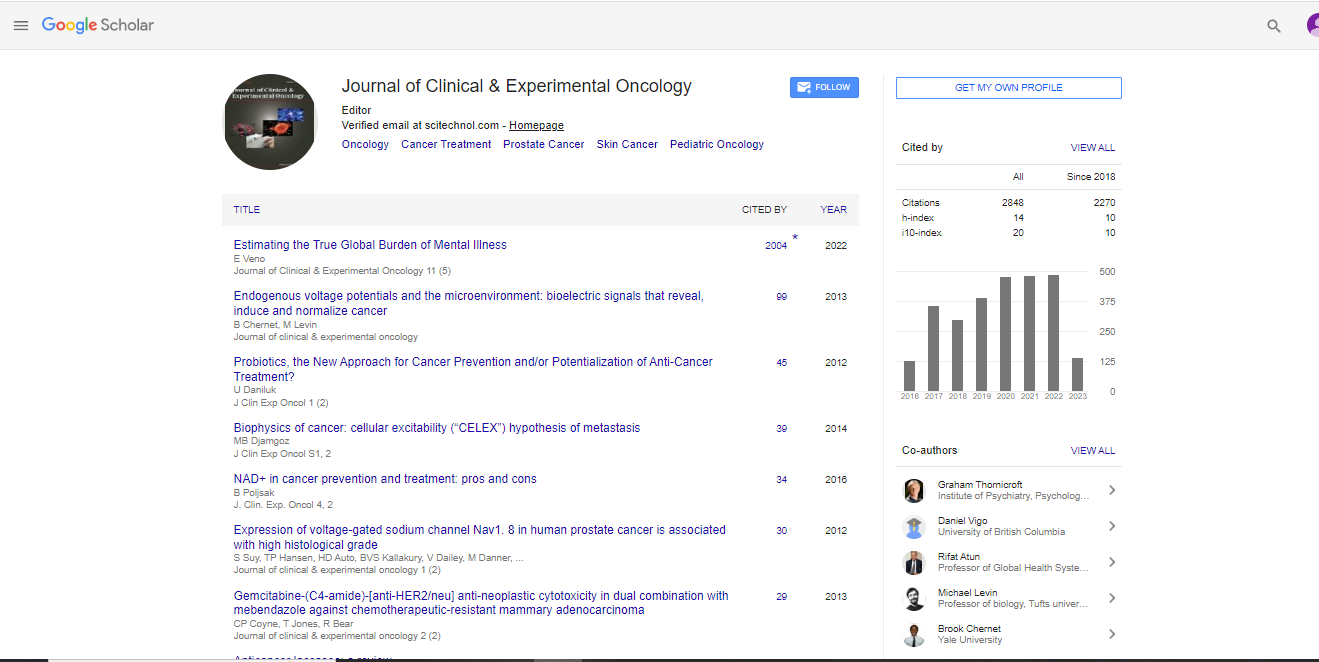Perspective, J Clin Exp Oncol Vol: 13 Issue: 2
Epidemiological Approaches to Cancer Surveillance and Screening
Jiang Zehin*
1Department of Radiology, Lanzhou University Second Hospital, Lanzhou, China
*Corresponding Author: Jiang Zehin,
Department of Radiology, Lanzhou University
Second Hospital, Lanzhou, China
E-mail: jiang_zehin@lus22.cn
Received date: 22 May, 2024, Manuscript No. JCEOG-24-143921;
Editor assigned date: 24 May, 2024, PreQC No. JCEOG-24-143921 (PQ);
Reviewed date: 07 June, 2024, QC No. JCEOG-24-143921;
Revised date: 14 June, 2024, Manuscript No. JCEOG-24-143921 (R);
Published date: 21 June, 2024, DOI: 10.4172/2324-9110.1000408
Citation: Zehin J (2024) Epidemiological Approaches to Cancer Surveillance and Screening. J Clin Exp Oncol 13:2.
Description
Cancer remains one of the leading causes of morbidity and mortality worldwide, necessitating robust strategies for its control and prevention. Epidemiology, the study of disease distribution and determinants in populations, plays a key role in understanding cancer patterns and informing public health interventions. It explores the epidemiological approaches to cancer surveillance and screening, emphasizing their significance, methodologies, challenges, and future directions. Cancer Surveillance involves the systematic collection, analysis, and interpretation of health data related to cancer incidence, prevalence, mortality, survival rates, and risk factors. Surveillance provides essential information for public health planning, resource allocation, and evaluating the effectiveness of cancer control programs.
Cancer Screening aims to detect cancer at an early, more treatable stage in asymptomatic individuals. Early detection through screening can lead to better outcomes, reduced mortality, and improved quality of life. Screening programs target high-risk populations and employ various methods to identify cancers before symptoms appear. Population-Based Cancer Registries (PBCRs) collect data on all cancer cases within a defined population. They provide comprehensive information on cancer incidence, survival, and prevalence, enabling epidemiologists to identify trends and disparities. Examples include the Surveillance, Epidemiology, and End Results (SEER) Program in the United States and the International Agency for Research on Cancer (IARC) databases.
Many countries have established national cancer surveillance programs to monitor cancer trends and outcomes. These programs integrate data from multiple sources, including cancer registries, hospital records, death certificates, and health surveys. The United States' National Program of Cancer Registries (NPCR) and the UK's National Cancer Registration and Analysis Service (NCRAS) are notable examples. Incidence data provide information into the number of new cancer cases, while mortality data reflect cancer-related deaths. Analyzing these metrics over time helps identify emerging trends, assess the impact of prevention efforts, and guide public health policies.
Cohort and case-control studies explores the associations between risk factors and cancer outcomes. These studies contribute to understanding the etiology of various cancers and identifying potential preventive measures. Large-scale studies like the Nurses' Health Study and the European Prospective Investigation into Cancer and Nutrition (EPIC) have provided valuable information into cancer epidemiology. National and international organizations develop cancer screening guidelines based on epidemiological evidence. Screening programs target cancers with a high burden and significant potential for early detection. Commonly screened cancers include breast, cervical, colorectal, and lung cancer. Guidelines outline the appropriate age groups, screening intervals, and methods for each type of cancer.
Mammography is a widely used screening tool for breast cancer. Epidemiological studies have shown that regular mammography screening can reduce breast cancer mortality by detecting tumors at an earlier, more treatable stage. Recommendations vary by country, but many guidelines suggest biennial screening for women aged 50 to 74. The Pap smear and Human Papilloma Virus (HPV) testing are essential components of cervical cancer screening. These tests detect precancerous lesions and HPV infections, allowing for timely intervention. Epidemiological data support the effectiveness of cervical cancer screening in reducing incidence and mortality, particularly in countries with organized screening programs.
Colorectal cancer screening includes non-invasive methods like Fecal Occult Blood Test (FOBT) and more invasive procedures like colonoscopy. Epidemiological studies demonstrate that regular screening can significantly reduce colorectal cancer incidence and mortality by identifying and removing precancerous polyps. Guidelines generally recommend screening for individuals aged 50 to 75. Low-Dose Computed Tomography (LDCT) screening is recommended for high-risk individuals, such as heavy smokers, to detect lung cancer early. Epidemiological evidence from trials like the National Lung Screening Trial (NLST) indicates that LDCT screening can reduce lung cancer mortality in this population. Guidelines typically target individuals aged 55 to 80 with a significant smoking history.
Ensuring the accuracy, completeness, and timeliness of cancer registry data is vital. Incomplete or inaccurate data can lead to biased estimates and misinform public health interventions. Efforts to standardize data collection and improve reporting practices are ongoing. Disparities in access to cancer screening and care persist, influenced by socioeconomic status, geographic location, race, and ethnicity. Addressing these inequities requires targeted outreach, education, and policies to ensure that all populations benefit from early detection and timely treatment.
Conclusion
Epidemiological approaches to cancer surveillance and screening are integral to reducing the global cancer burden. Through robust data collection, analysis, and evidence-based screening programs, epidemiology informs public health strategies, guides policy decisions, and ultimately saves lives. Overcoming challenges related to data quality, access, and over diagnosis requires ongoing collaboration, innovation, and commitment to equity. As technology advances and precision medicine evolves, the future of cancer surveillance and screening holds great potential for more effective, personalized and accessible cancer care.
 Spanish
Spanish  Chinese
Chinese  Russian
Russian  German
German  French
French  Japanese
Japanese  Portuguese
Portuguese  Hindi
Hindi 



